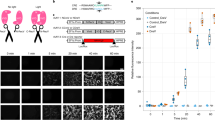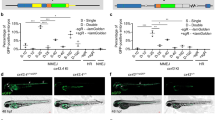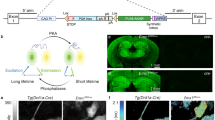Abstract
In the transgenic multicolor labeling strategy called 'Brainbow', Cre-loxP recombination is used to create a stochastic choice of expression among fluorescent proteins, resulting in the indelible marking of mouse neurons with multiple distinct colors. This method has been adapted to non-neuronal cells in mice and to neurons in fish and flies, but its full potential has yet to be realized in the mouse brain. Here we present several lines of mice that overcome limitations of the initial lines, and we report an adaptation of the method for use in adeno-associated viral vectors. We also provide technical advice about how best to image Brainbow-expressing tissue.
This is a preview of subscription content, access via your institution
Access options
Subscribe to this journal
Receive 12 print issues and online access
$259.00 per year
only $21.58 per issue
Buy this article
- Purchase on Springer Link
- Instant access to full article PDF
Prices may be subject to local taxes which are calculated during checkout






Similar content being viewed by others
References
Tsien, R.Y. The green fluorescent protein. Annu. Rev. Biochem. 67, 509–544 (1998).
Heim, R. & Tsien, R.Y. Engineering green fluorescent protein for improved brightness, longer wavelengths and fluorescence resonance energy transfer. Curr. Biol. 6, 178–182 (1996).
Rizzo, M.A., Springer, G.H., Granada, B. & Piston, D.W. An improved cyan fluorescent protein variant useful for FRET. Nat. Biotechnol. 22, 445–449 (2004).
Shagin, D.A. et al. GFP-like proteins as ubiquitous metazoan superfamily: evolution of functional features and structural complexity. Mol. Biol. Evol. 21, 841–850 (2004).
Ai, H.W., Henderson, J.N., Remington, S.J. & Campbell, R.E. Directed evolution of a monomeric, bright and photostable version of Clavularia cyan fluorescent protein: structural characterization and applications in fluorescence imaging. Biochem. J. 400, 531–540 (2006).
Subach, O.M. et al. Conversion of red fluorescent protein into a bright blue probe. Chem. Biol. 15, 1116–1124 (2008).
Ai, H.W., Shaner, N.C., Cheng, Z., Tsien, R.Y. & Campbell, R.E. Exploration of new chromophore structures leads to the identification of improved blue fluorescent proteins. Biochemistry 46, 5904–5910 (2007).
Karasawa, S., Araki, T., Nagai, T., Mizuno, H. & Miyawaki, A. Cyan-emitting and orange-emitting fluorescent proteins as a donor/acceptor pair for fluorescence resonance energy transfer. Biochem. J. 381, 307–312 (2004).
Shaner, N.C. et al. Improving the photostability of bright monomeric orange and red fluorescent proteins. Nat. Methods 5, 545–551 (2008).
Shaner, N.C. et al. Improved monomeric red, orange and yellow fluorescent proteins derived from Discosoma sp. red fluorescent protein. Nat. Biotechnol. 22, 1567–1572 (2004).
Shcherbo, D. et al. Far-red fluorescent tags for protein imaging in living tissues. Biochem. J. 418, 567–574 (2009).
Shcherbo, D. et al. Near-infrared fluorescent proteins. Nat. Methods 7, 827–829 (2010).
Shaner, N.C., Steinbach, P.A. & Tsien, R.Y. A guide to choosing fluorescent proteins. Nat. Methods 2, 905–909 (2005).
Feng, G. et al. Imaging neuronal subsets in transgenic mice expressing multiple spectral variants of GFP. Neuron 28, 41–51 (2000).
Livet, J. et al. Transgenic strategies for combinatorial expression of fluorescent proteins in the nervous system. Nature 450, 56–62 (2007).
Branda, C.S. & Dymecki, S.M. Talking about a revolution: the impact of site-specific recombinases on genetic analyses in mice. Dev. Cell 6, 7–28 (2004).
Snippert, H.J. et al. Intestinal crypt homeostasis results from neutral competition between symmetrically dividing Lgr5 stem cells. Cell 143, 134–144 (2010).
Red-Horse, K., Ueno, H., Weissman, I.L. & Krasnow, M.A. Coronary arteries form by developmental reprogramming of venous cells. Nature 464, 549–553 (2010).
Rinkevich, Y., Lindau, P., Ueno, H., Longaker, M.T. & Weissman, I.L. Germ-layer and lineage-restricted stem/progenitors regenerate the mouse digit tip. Nature 476, 409–413 (2011).
Schepers, A.G. et al. Lineage tracing reveals Lgr5+ stem cell activity in mouse intestinal adenomas. Science 337, 730–735 (2012).
Tabansky, I. et al. Developmental bias in cleavage-stage mouse blastomeres. Curr. Biol. 23, 21–31 (2013).
Gupta, V. & Poss, K.D. Clonally dominant cardiomyocytes direct heart morphogenesis. Nature 484, 479–484 (2012).
Pan, Y.A., Livet, J., Sanes, J.R., Lichtman, J.W. & Schier, A.F. Multicolor Brainbow imaging in zebrafish. Cold Spring Harb. Protoc. 2011, pdb.prot5546 (2011).
Hampel, S. et al. Drosophila Brainbow: a recombinase-based fluorescence labeling technique to subdivide neural expression patterns. Nat. Methods 8, 253–259 (2011).
Hadjieconomou, D. et al. Flybow: genetic multicolor cell labeling for neural circuit analysis in Drosophila melanogaster. Nat. Methods 8, 260–266 (2011).
Lang, C., Guo, X., Kerschensteiner, M. & Bareyre, F.M. Single collateral reconstructions reveal distinct phases of corticospinal remodeling after spinal cord injury. PLoS ONE 7, e30461 (2012).
Badaloni, A. et al. Transgenic mice expressing a dual, CRE-inducible reporter for the analysis of axon guidance and synaptogenesis. Genesis 45, 405–412 (2007).
Lichtman, J.W., Livet, J. & Sanes, J.R. A technicolour approach to the connectome. Nat. Rev. Neurosci. 9, 417–422 (2008).
Lakso, M. et al. Targeted oncogene activation by site-specific recombination in transgenic mice. Proc. Natl. Acad. Sci. USA 89, 6232–6236 (1992).
Paterna, J.C., Moccetti, T., Mura, A., Feldon, J. & Büeler, H. Influence of promoter and WHV post-transcriptional regulatory element on AAV-mediated transgene expression in the rat brain. Gene Ther. 7, 1304–1311 (2000).
Madisen, L. et al. A robust and high-throughput Cre reporting and characterization system for the whole mouse brain. Nat. Neurosci. 13, 133–140 (2010).
Hippenmeyer, S. et al. A developmental switch in the response of DRG neurons to ETS transcription factor signaling. PLoS Biol. 3, e159 (2005).
Srinivas, S. et al. Cre reporter strains produced by targeted insertion of EYFP and ECFP into the ROSA26 locus. BMC Dev. Biol. 1, 4 (2001).
Guo, C., Yang, W. & Lobe, C.G. A Cre recombinase transgene with mosaic, widespread tamoxifen-inducible action. Genesis 32, 8–18 (2002).
Zhang, X.M. et al. Highly restricted expression of Cre recombinase in cerebellar Purkinje cells. Genesis 40, 45–51 (2004).
Rossi, J. et al. Melanocortin-4 receptors expressed by cholinergic neurons regulate energy balance and glucose homeostasis. Cell Metab. 13, 195–204 (2011).
Campsall, K.D., Mazerolle, C.J., De Repentingy, Y., Kothary, R. & Wallace, V.A. Characterization of transgene expression and Cre recombinase activity in a panel of Thy-1 promoter-Cre transgenic mice. Dev. Dyn. 224, 135–143 (2002).
Bunting, M., Bernstein, K.E., Greer, J.M., Capecchi, M.R. & Thomas, K.R. Targeting genes for self-excision in the germ line. Genes Dev. 13, 1524–1528 (1999).
McLeod, M., Craft, S. & Broach, J.R. Identification of the crossover site during FLP-mediated recombination in the Saccharomyces cerevisiae plasmid 2 μm circle. Mol. Cell Biol. 6, 3357–3367 (1986).
Schlake, T. & Bode, J. Use of mutated FLP recognition target (FRT) sites for the exchange of expression cassettes at defined chromosomal loci. Biochemistry 33, 12746–12751 (1994).
Peroutka, R.J., Elshourbagy, N., Piech, T. & Butt, T.R. Enhanced protein expression in mammalian cells using engineered SUMO fusions: secreted phospholipase A2. Protein Sci. 17, 1586–1595 (2008).
Farley, F.W., Soriano, P., Steffen, L.S. & Dymecki, S.M. Widespread recombinase expression using FLPeR (flipper) mice. Genesis 28, 106–110 (2000).
Awatramani, R., Soriano, P., Rodriguez, C., Mai, J.J. & Dymecki, S.M. Cryptic boundaries in roof plate and choroid plexus identified by intersectional gene activation. Nat. Genet. 35, 70–75 (2003).
Araki, K., Okada, Y., Araki, M. & Yamamura, K. Comparative analysis of right element mutant loxP sites on recombination efficiency in embryonic stem cells. BMC Biotechnol. 10, 29 (2010).
Entenberg, D. et al. Setup and use of a two-laser multiphoton microscope for multichannel intravital fluorescence imaging. Nat. Protoc. 6, 1500–1520 (2011).
Mahou, P. et al. Multicolor two-photon tissue imaging by wavelength mixing. Nat. Methods 9, 815–818 (2012).
Wang, K. et al. Three-color femtosecond source for simultaneous excitation of three fluorescent proteins in two-photon fluorescence microscopy. Biomed. Opt. Express 3, 1972–1977 (2012).
Conchello, J.A. & Lichtman, J.W. Optical sectioning microscopy. Nat. Methods 2, 920–931 (2005).
Ducros, M. et al. Efficient large core fiber-based detection for multi-channel two-photon fluorescence microscopy and spectral unmixing. J. Neurosci. Methods 198, 172–180 (2011).
Card, J.P. et al. A dual infection pseudorabies virus conditional reporter approach to identify projections to collateralized neurons in complex neural circuits. PLoS ONE 6, e21141 (2011).
Hancock, J.F., Cadwallader, K., Paterson, H. & Marshall, C.J.A. CAAX or a CAAL motif and a second signal are sufficient for plasma membrane targeting of ras proteins. EMBO J. 10, 4033–4039 (1991).
Acknowledgements
This work was supported by grants from the US National Institutes of Health (5U24NS063931) and the Gatsby Charitable Foundation and by Collaborative Innovation Award no. 43667 from the Howard Hughes Medical Institute. We thank S. Haddad for assistance with mouse colony maintenance; X. Duan, L. Bogart and J. Lefebvre for testing Brainbow mice and AAVs; R.W. Draft for valuable discussions and advice; R.Y. Tsien (University of California, San Diego) for mOrange2 and TagRFPt; and D.M. Chudakov (Institute of Bioorganic Chemistry of the Russian Academy of Sciences) for TagBFP, PhiYFP, mKate2 and eqFP650.
Author information
Authors and Affiliations
Contributions
D.C., K.B.C. and T.L. performed experiments. D.C., J.W.L. and J.R.S. designed experiments, interpreted results and wrote the manuscript.
Corresponding author
Ethics declarations
Competing interests
The authors declare no competing financial interests.
Supplementary information
Supplementary Text and Figures
Supplementary Figures 1–11 and Supplementary Tables 1 and 2 (PDF 2371 kb)
Motor axons and neuromuscular junctions in extraocular muscle
The video shows confocal z–cross-section images and three-dimensional reconstructions on the left and right, respectively, for a Brainbow 3.0 (line D) Islet-Cre mouse with antibody amplification. EGFP shown in blue, mOrange2 in green and mKate2 in red. (AVI 6653 kb)
Cerebellum
The video shows confocal z–cross-section images for a Brainbow 3.1 (line 3) L7-Cre mouse with antibody amplification. EGFP shown in blue, mOrange2 in green and mKate2 in red. (AVI 5501 kb)
Parvalbumin-positive interneurons in cerebral cortex
The video shows confocal z cross-sections and three-dimensional reconstructions on the left and right, respectively. Cortex was labeled by Brainbow AAVs injected into a parvalbumin-Cre mouse, and sections were immunostained. mTFP and EYFP are shown green, TagBFP in blue and mCherry in red. (AVI 6597 kb)
Rights and permissions
About this article
Cite this article
Cai, D., Cohen, K., Luo, T. et al. Improved tools for the Brainbow toolbox. Nat Methods 10, 540–547 (2013). https://doi.org/10.1038/nmeth.2450
Received:
Accepted:
Published:
Issue Date:
DOI: https://doi.org/10.1038/nmeth.2450
This article is cited by
-
Characterisation of NPFF-expressing neurons in the superficial dorsal horn of the mouse spinal cord
Scientific Reports (2023)
-
Dual-expression system for blue fluorescent protein optimization
Scientific Reports (2022)
-
Live-cell fluorescence spectral imaging as a data science challenge
Biophysical Reviews (2022)
-
Multicolor strategies for investigating clonal expansion and tissue plasticity
Cellular and Molecular Life Sciences (2022)
-
Tissue clearing
Nature Reviews Methods Primers (2021)



